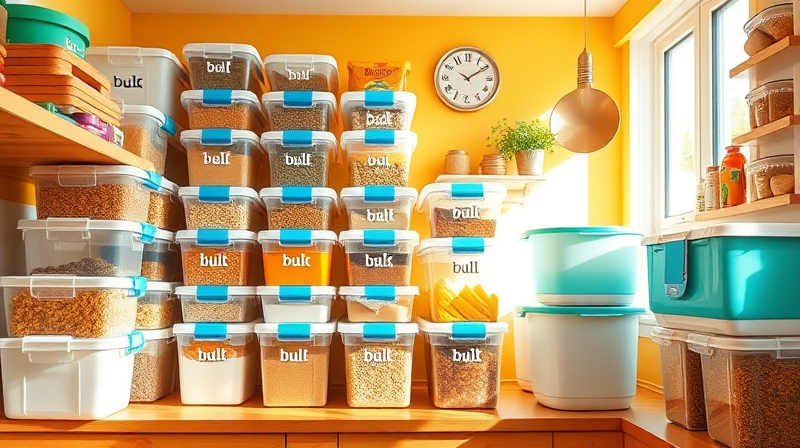In these challenging times of unpredictable supply chains and rising prices, it is more important than ever to approach pantry stocking with a strategic mind. A well-prepared pantry not only keeps your household nourished but also provides peace of mind during unexpected disruptions. By understanding the key elements of smart stock-up strategies, you can secure your pantry without stretching your budget too thin.
Building a resilient pantry begins with knowing exactly which staple items are necessary, how to monitor their prices, and when to buy them. This article is designed to offer inspiring, practical advice on creating an effective plan tailored for today’s economic challenges.
Understanding the Current Pantry Landscape
Recent disruptions in supply chains have significantly impacted the availability and cost of everyday staples. Canned goods, grains, and other shelf-stable products have become challenging to find and are often expensive due to increased demand and production issues. Experts recommend planning your purchases strategically rather than resorting to panic buying. This approach not only saves money but also reduces waste by ensuring that every item purchased is a conscious and necessary decision.
A thoughtful review of your pantry allows you to recognize existing stock and avoid redundant purchases, thereby safeguarding you from overspending on duplicate items.
Pantry Must-Haves for a Smart Stock-Up
Efficient stocking begins with identifying the types of food that you can rely on during times of uncertainty. Below are the essential categories to consider when filling your pantry:
- Grains and Carbohydrates: Items such as rice, pasta, oats, and bread flours are indispensable for a balanced diet. These items are not only cost-effective but also incredibly versatile. Alternatives, including gluten-free options, provide additional choices for diverse dietary needs.
- Protein Sources: Maintaining a supply of beans, lentils, and canned meats is crucial as these provide necessary protein and are known for their long shelf lives. Although ready-to-eat options like soups and chilies can be useful, single-ingredient protein sources are generally healthier and less processed.
- Canned and Shelf-Stable Goods: Stocking up on canned vegetables, tomatoes, and coconut milk ensures that your pantry remains flexible for recipe modifications while also offering the convenience of long-lasting ingredients.
- Oils and Cooking Essentials: A variety of oils such as olive oil, coconut oil, and ghee supports diverse cooking methods and recipes. Complement these with a selection of spices to elevate your meals without resorting to processed flavorings.
- Snacks and Quick Bites: Affordable yet nutritious options like granola, crackers, and nuts provide energy and nourishment during busy days or emergencies.
Stocking your pantry with these essentials ensures you have a versatile and cost-effective foundation, allowing you to manage your food resources wisely.
Smart Stock-Up Techniques to Stretch Your Budget
Creating a well-organized pantry goes far beyond simple shopping. It involves an evolving process of continuously assessing, updating, and managing your food supplies. Here are some dynamic strategies to maximize the benefits of your purchases:
- Inventory First: Begin by taking a detailed look at what already exists in your pantry. This prevents overbuying and highlights genuine needs rather than indulging in redundant items. A tidy inventory not only saves money but also helps in meal planning.
- Focus on Single-Ingredient Staples: Emphasize purchasing basic items that serve as the backbone of many recipes. This allows you to create a multitude of meals with less waste while also serving to spread nutritional value over several dishes.
- Opt for Generic Brands: Store brands often provide the same quality as their branded counterparts. Making this switch can lead to significant savings over time without compromising on the quality of your food.
- Monitor Price Fluctuations: Keeping a vigilant eye on price changes and anticipated spikes, especially on canned goods, enables you to plan your shopping trips during sales or before costs increase further.
- Balance Convenience with Nutritional Value: Although ready-to-eat meals have their place, especially in emergencies, it is preferable to prioritize shelf-stable, single-ingredient products that offer greater nutritional value and flexibility in meal preparation.
- Adapt to Emerging Trends: Rapid changes in the marketplace mean that stock levels can plummet in a matter of hours. Stocking up gradually, rather than all at once, is a smart way to maintain readiness without unnecessary financial strain.
Each of these techniques reinforces a philosophy of thoughtful consumption that is both sustainable and budget-friendly.
Maintaining a Clean and Organized Pantry
Once your pantry is well-stocked, the next step is careful management. Regularly checking the expiration dates, reorganizing items into logical categories, and disposing of outdated products are imperative practices that help prevent waste and ensure that your food remains safe to consume. Keeping your pantry organized not only maximizes space but also enhances meal planning and overall kitchen efficiency.
An organized pantry means you are more likely to cook meals using what you have rather than relying on external purchases, thereby locking in both cost savings and healthier eating habits.
In conclusion, building and maintaining a resilient pantry with smart stock-up strategies empowers you to navigate the uncertain aspects of modern supply chains. By integrating meticulous planning, sticking to single-ingredient products, and remaining vigilant about price trends, you can ensure your household remains nourished without overspending. This balanced approach offers both practical and emotional reassurance, turning your pantry into a source of confidence during testing times.
Embrace the opportunity to adapt your shopping habits in ways that are both economical and sustainable. With each strategic purchase, you are not just filling your shelves, you are building a foundation for a resilient future.








